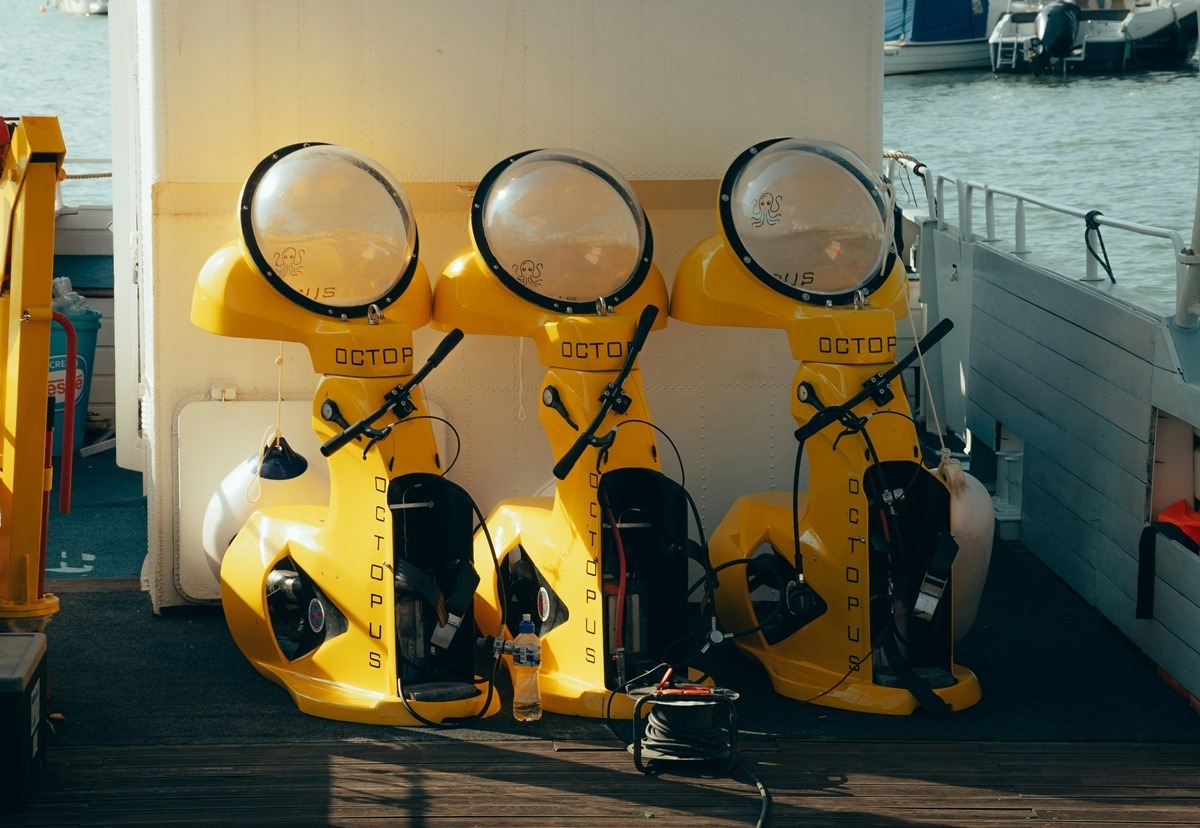
The diving industry has always been shaped by innovation, from the invention of the Aqua-Lung in the 1940s to today’s advanced rebreathers. Now, a new wave of technology is redefining how dive centers operate and train divers: underwater robotics and artificial intelligence (AI). Far from being futuristic concepts, these tools are already making their way into training programs, dive operations, and marine research. For dive center owners and managers, understanding how these technologies impact the business of diving is no longer optional; it’s essential for staying competitive in a rapidly evolving market.
This article explores the practical implications of underwater robotics and AI in diving, with a focus on how they enhance training, improve operational efficiency, and unlock new opportunities for dive centers worldwide.
The Rise of Underwater Robotics in Diving
Underwater robotics, also referred to as marine robotics innovation, has traditionally been associated with scientific exploration, oil and gas industries, and naval operations. Today, however, robotic diving solutions are crossing over into recreational and professional scuba diving. Autonomous Underwater Vehicles (AUVs) and Remotely Operated Vehicles (ROVs) are being adapted for dive training, environmental monitoring, and operational support.
For dive training centers, this technology represents a shift from theory-based learning toward interactive, tech-assisted practice. For example, robotic underwater training systems can simulate real underwater challenges like navigation in low visibility, equipment malfunctions, or buoyancy control, without exposing divers to unnecessary risk. This prepares students more effectively for advanced diving courses and ensures higher levels of confidence and safety once they enter open water.
Moreover, robotic diving equipment can now perform tasks that would otherwise require human divers, such as inspecting underwater infrastructure, locating lost gear, or mapping dive sites. This not only improves efficiency but also reduces liability risks for dive centers managing large groups of students or complex dives.
AI-Powered Efficiency in Dive Operations
AI in dive operations goes far beyond scheduling and logistics. Today’s AI-powered underwater exploration tools are integrated into dive planning systems, real-time monitoring, and even post-dive analysis. These AI-driven dive efficiency tools allow dive centers to operate with precision while improving both safety and profitability.
For example, AI and diving safety applications can predict risks by analyzing real-time data from dive computers, smart underwater technology, and environmental sensors. These systems can warn divers and instructors about rapid ascents, unsafe nitrogen levels, or strong current conditions, making them indispensable for both recreational and technical training.
At the operational level, integrated diving technologies streamline the way dive centers manage everything from equipment rentals to certification tracking. With AI-driven analytics, managers can forecast busy periods, optimize staff scheduling, and even automate student progress tracking. This creates a seamless experience for both divers and instructors while giving dive centers a competitive edge in customer service.
Underwater Robotics in Training: Raising the Standards
Dive training technology has historically relied on classroom theory, confined-water practice, and open-water experience. With robotics in scuba diving, a new dimension is added to this process.
Robotic-assisted training introduces interactive scenarios where divers can engage with underwater robots that mimic marine conditions or provide real-time feedback. For instance, underwater robot applications include:
- Guiding students through obstacle courses that simulate shipwreck penetrations or cave navigation.
- Assisting instructors in demonstrating buoyancy control and trim techniques with high precision.
- Providing data on air consumption rates, depth, and positioning during training dives.
By integrating robotics in scuba diving education, instructors can deliver consistent, measurable, and repeatable experiences that enhance both beginner and advanced courses. In addition, dive training with robotics can significantly reduce human error, allowing students to master critical skills before they face challenging open-water environments.
For dive centers that want to differentiate themselves, offering training enhanced by smart dive technologies positions them as industry leaders in innovative diving systems.

The Role of AI in Underwater Exploration and Research
AI in underwater exploration is already transforming marine biology, archaeology, and conservation. For dive centers involved in research projects or eco-tourism, collaborating with AI-powered underwater exploration tools opens new business models.
Autonomous underwater vehicles and AI in marine research can map reefs, identify species, and monitor environmental changes more accurately than manual surveys. These AI-driven systems not only support scientific discovery but also create unique opportunities for divers to participate in citizen science. Dive centers can design programs where recreational divers assist in data collection while AI systems handle processing and analysis.
This combination of robotics and marine AI solutions enhances the educational and conservation value of dives, giving centers a compelling story to market to environmentally conscious customers.
Enhancing Dive Safety Through Smart Technologies
One of the greatest benefits of AI and robotics is their role in improving diving safety. AI and diving safety tools integrate with wearable dive computers, underwater communication systems, and robotic assistants to provide real-time alerts.
For example, AI-powered underwater exploration devices can detect early signs of equipment failure, alerting divers before problems escalate. Robotic diving equipment can also assist in rescue scenarios by guiding disoriented divers back to the surface or transporting emergency supplies underwater.
As smart dive technologies become more affordable, they are expected to become standard equipment for dive operations. By incorporating AI in dive operations, centers can reduce liability risks while instilling confidence in students and clients alike.
Economic and Operational Implications for Dive Centers
Adopting underwater robotics and AI requires investment, but the return on investment can be significant. Here’s why:
- Increased Training Capacity: Robotic underwater training reduces instructor workload, allowing centers to accommodate more students without compromising safety.
- Operational Efficiency: AI in dive operations minimizes administrative overhead through automated scheduling, resource allocation, and performance tracking.
- Market Differentiation: Offering advanced diving courses supported by robotics and AI-powered underwater exploration sets a dive center apart in a crowded market.
- Sustainability: AI in marine research supports eco-friendly initiatives, which can attract eco-conscious customers and partnerships with NGOs.
The future of dive operations will likely see a hybrid model, where human expertise is complemented by robotic diving solutions and AI-driven systems. Dive centers that embrace this integration will be better equipped to thrive in a technology-forward industry.
Challenges and Considerations
While the benefits of underwater robotics and AI are clear, there are also challenges to consider. Cost is a major factor - autonomous underwater vehicles and advanced robotic diving equipment can require significant upfront investment. Training staff to use these tools effectively is another hurdle, as is ensuring compliance with safety and certification standards.
Additionally, while diving with AI technology enhances experiences, it’s important that dive centers strike a balance between human skill development and reliance on smart underwater technology. Divers must remain competent and self-reliant even when supported by innovative diving systems.
However, as underwater technology innovation advances and costs decrease, these barriers are expected to diminish. Early adopters will enjoy the advantage of being positioned as leaders in dive operation advancements.
The Future of Dive Operations: A Hybrid Human-Tech Model
Looking ahead, the future of dive operations will be defined by a partnership between divers and machines. Robot-assisted diving, AI-driven dive efficiency, and integrated diving technologies will not replace human divers but will augment their abilities.
From training systems that replicate real-world scenarios to deep sea robotics assisting in exploration, the industry is moving toward smarter, safer, and more efficient operations. For dive centers, this is an opportunity to rethink their role, not just as providers of recreational experiences, but as leaders in underwater technology innovation.
The next generation of divers will expect training and exploration experiences that incorporate robotics in scuba diving and AI-powered systems. For forward-thinking dive centers, the question is not if they should adopt these technologies, but when.
Conclusion: Embracing the Tech Tide
Underwater robotics and AI are no longer confined to research labs and industrial applications, they are reshaping the very foundations of dive training and operations. From enhancing safety and efficiency to elevating the diver experience, these technologies open doors for dive centers ready to embrace innovation.
As marine robotics innovation continues to accelerate, dive centers that integrate AI-powered underwater exploration, robotic diving solutions, and smart underwater technology into their offerings will be at the forefront of the industry’s evolution.
For dive center owners and managers, now is the time to explore how these tools can streamline your operations, differentiate your services, and future-proof your business.
👉 Ready to see how technology can simplify and elevate your operations? Book a demo with Bloowatch today.
Sources
National Oceanic and Atmospheric Administration (NOAA). Autonomous Underwater Vehicles (AUVs) in Marine Research.UNESCO – Intergovernmental Oceanographic Commission. The Role of Marine Robotics in Ocean Science.
MIT Technology Review. How Artificial Intelligence is Changing Exploration of the Ocean.
Oceanographic Magazine. Robotics in Marine Conservation.
IEEE Xplore. Applications of AI and Robotics in Diving and Underwater Operations.
United Nations Environment Programme (UNEP). Technology and Innovation for Sustainable Oceans.



